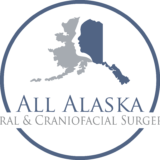The temporomandibular joint (TMJ) is located in front of our ear where the skull and the lower jaw meet. The TMJ is the most constantly used joint in the body, allowing the lower jaw to move and function. Because of this high level of joint stress, injury and pain of the TMJ is not uncommon. If the TMJ is impaired, a condition called temporomandibular disorder (TMD) results.
Diagnosing TMJ disorders can be complex and require different diagnostic procedures and imaging under the supervision of your Oral and Maxillofacial Surgeon. If non-surgical treatment such as short-term non-steroidal anti-inflammatory drugs or muscle relaxing medications, dental bite splint therapy and stress management are unsuccessful or if there is clear joint damage, surgery may be needed. Your surgeon will help you understand you treatment options after a thorough TMJ evaluation.
Because the temporomandibular joint (TMJ) is the busiest joint in the body, it can certainly be affected by lots of different factors.
Sometimes the cause of TMJ disorders are really quite difficult to determine. Sometimes, it’s a combination of things that cause this discomfort, including arthritis, a jaw injury, teeth clenching or grinding, and even genetics.
Quite often, the pain associated with TMD – temporomandibular joint disorder – is temporary and is easily relieved with some self-managed care and other non-surgical treatments, but at times surgical treatment is needed if more conservative approaches to pain relief are not successful or if joint damage is indeed present.
What are the symptoms of TMD?
Though it can be difficult to diagnose a temporomandibular joint disorder and imaging may be necessary to make a definite determination, some of the common signs that indicate there may be a problem are as follows:
Pain in one or both of the temporomandibular joints, which are located in front of the ear, attaching the mandible (lower jaw) and the temporal bone on the side of the skull
- Tenderness or pain in the jaw itself
- Earaches or pain around your ear
- Aching pain in other parts of the face
- A clicking sound when you open and close your mouth
- Difficulty chewing
- Pain while chewing
- Difficulty opening or closing the mouth or locking of the joint
It’s important to understand that any of these symptoms individually or a combination of these symptoms may not indicate a TMJ disorder, which is why it’s necessary to be evaluated by a professional, who will perform a thorough examination and order the correct tests to make the determination.
Why do TMJ disorders happen?
The TMJ both rotates and translates forward and backward, making it one of the most complex joints in the body. Repetitive motion or other issues, like arthritis, can wear down the cartilage covering the bones.
In addition, the small shock-absorbing disk that separates the joint bones that interact with each other can also erode or move out of alignment, causing pain and other symptoms.
Although the causes of TMJ pain and dysfunction are known to be many, chronic clenching or grinding of the teeth are a leading cause.
Additionally, accidents that involve the joint or a blow to that area can affect the TMJ and make surgery necessary.
TMJ surgery and other procedures
If you have temporomandibular joint issues and conservative therapies such as over-the-counter pain relievers or dental bite splint treatment have not helped, it’s likely your oral and maxillofacial surgeon might suggest one of these options.
- Arthrocentesis – This involves the insertion of small cannulas into the joint so that fluid and/or medications can be sent through it to remove debris and inflammatory byproducts.
- Injections – Some patients respond well to corticosteroid injections in the joint. Botox is also sometimes used for facial pain caused by muscle strain.
- Arthroscopic surgery – A simpler alternative to the more complex open joint surgery, TMJ arthroscopic surgery involves placing a small thin tube into the joint space, after which an arthroscope is inserted and small surgical instruments are used for surgery. Healing time is decreased and risks and complications are far fewer than with open joint surgery.
- Modified condylotomy – During this procedure, surgery is performed on the mandible (lower jaw) but not on the TMJ. It may help when clicking and locking are a problem.
- Open joint surgery – Suggested when there is a structural problem with the TMJ, this surgery involves repairing or completely replacing that joint. Open surgery poses more risks than the other treatments and will most commonly be recommended if your surgeon believes it is the only measure that will solve your particular TMJ issue.
Remember, your surgeon will do a thorough examination and evaluation of your TMD and will discuss options with you, offering the least invasive methods intended to alleviate pain and dysfunction related to your temporomandibular joint.
